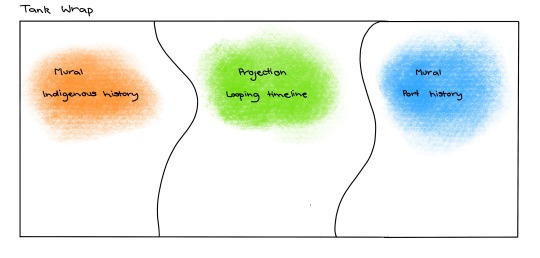Text
Final Concept Pitch and Representative Image
“The History Round” involves a combination of painted murals and a digitally projected history timeline video on the old tank at Northshore. Aimed at addressing Northshore’s rich history in a creative way, “The History Round” will feature both indigenous art and a mural depicting Hamilton’s wharf history. The centre projection will be modifiable to help maintain engagement, and can be changed to accompany special events.

(March 24 2021)
0 notes
Text
Skills Needed
Skills needed to realise this project include:
Project management - to coordinate the different aspects
Interactive design / animation - to help with the creation of the projection video
IT skills - to help with the upload of the video to the Northshore website
Communication - to consult with local community (indigenous community and residents)
(March 23 2021)
0 notes
Text
Draft Concept Pitch
“The History Round” involves a combination of painted murals and a digitally projected history timeline video on the old tank at Northshore. Aimed at addressing Northshore’s rich history in a creative way, “The History Round” will feature both indigenous art and a mural depicting Hamilton’s wharf history. The centre projection will be modifiable to help maintain engagement, and can be changed to accompany special events.
(March 22 2021)
0 notes
Text
Addressing Key Criteria
Responds to the Site and Client Brief
"The History Round" activates the site by building on existing infrastructure and drawing on the history of Northshore
It reflects Northshore's vision to "immerse residents, workers, and visitors in riverside creativity and culture" by creating a new creative attraction
It helps add colour and creativity across the site, building on the existing tenants including Eat Street
Adds value by creating an attraction available 7 days a week, rather than just 3 nights
Originality
Draws on the physical and historical features of Northshore by using existing infrastructure, and building on its history in creative ways
There is nothing like it existing at Northshore or around Brisbane currently - painted tanks and silos exist in western Queensland but they are very removed from major cities
Visitors will want to revisit the site as the use of a projector means the images projected on the centre of the tank can evolve and change to stay relevant, and can be used in collaboration with current events
Audience Engagement, Ethics, and Diversity
Key stakeholders include new and current residents, destination visitors, as well as tenants and occupiers of the Northshore site
The target audience of this particular project is new and current residents and destination visitors
"The History Round" actively engages, sustains, and grows this audience by creating an iconic destination at the site that they will want to visit. Because of the ability for the projection to be modified, it will sustain this engagement and draw visitors back to the site
Local Indigenous communities will be actively engaged and consulted with throughout the project through community meetings and contact with local indigenous leaders
Feasibility, Sustainability & Enduring Significance
The project falls within the $70,000 budget and is possible to implement within 3 years
It can be refreshed and adapted by touching up the murals when required and altering the projection displayed in the centre
Because the main part of the project, the tank, is already on site, the project is environmentally sustainable as it doesn't require many new materials
Once it is implemented, it will require minimal upkeep making it economically sustainable
Will last at least 10 years
(March 22 2021)
0 notes
Text
Notes from history of Northshore
Aboriginal people of the Turrbal language group lived in Northshore
The area provided ample food resources including fish, shellfish, and the marine worm
Northshore was the scene of tournaments and Corroborees
Shallowness of the river provided convenient places to cross the river at low tide
1820s saw the establishment of a penal colony
In 1844, Brisbane was declared a port of entry for overseas shipping, despite the shallow bar and the Eagle Farm 'flats' which continued to impede Brisbane's development as a port
In the 1860s channels were dredged in the river to improve access
From1871 to 1877 the river was widened and deepened
Population of Hamilton and Ascot boomed in the 1880s - dredging to make way for larger ships continued. Floods in 1887, 1890, and 1893 washed sediment down the river into the dredged channels, reducing them by 3 feet
Training walls for the river began in 1898 - dredge spoil was pumped to the other side of the walls
Hamilton became a town in 1904 and the wall was completed in 1906
Ships bringing members of the Australian armed forces home from war regularly berthed at Hamilton during WWII
Dredging had been ignored during the war so large quantities needed to be removed in 1949
By the end of the 1940s, Brisbane had become a major port
Gateway bridge opened in 1986
First city cat service began operation in 1996
(March 22 2021)
0 notes
Text
Cost Research and Estimation
Key costs of the project include:
Both murals
Creation of timeline video
Projection costs
Tank preparation
Website
Mural pricing depends on the artist and the size of the mural. Since the size of the tank is unknown, the cost for this can only be estimated based on other examples. The Silo Art Trail, which features a compilation of painted silos in Queensland, was allocated $40,000 - $50,000 per silo (Christensen, 2019). Since the tank at Northshore is not as big as a grain silo, approximately $30,000 of the budget can be allocated to both murals. This price should include the artist fee, and most paint used in the project.
The cost of creating the timeline video to be projected can also only be estimated. For a high quality 2-3 minute video with no audio, approximately $10,000 - $15,000 of the budget will be allocated.
The other major cost of the project will be the installation of the projector. Information about how much projection mapping and installation will cost depends greatly on the project, so this is hard to estimate. Approximately $20,000 will be allocated for the installation of the projector, however this cost may change.
Other costs of the project include any other work needed to be done to the tank, such as removal of graffiti, and the cost of uploading the time line video to the Northshore website. The remaining $5,000 - $10,000 of the budget will be allocated to this.
Because of the high costs of the project, it is unlikely that a separate interactive timeline with more detailed information will be able to be created, however this extension could be completed at a later date once more funding becomes available.
Christensen, A. (2019). Silo art: What you need to know. Country News. https://www.countrynews.com.au/valleygallery/2019/10/28/86356/silo-art-what-you-need-to-know
(March 22 2021)
0 notes
Text
Expanding on Idea
Expanding on my initial idea of using projections and murals on the water tank, a combination of paintings and projected images that wrap around the tank would create an eye catching destination at Northshore.
The images on the tank would include 2 paintings, as well as a projected image. These two murals would be visual representations of the history of Northshore - one relating to the Indigenous history of the site and one relating to its port heritage. In the centre of these two images, a space on the tank will be left clear to allow for the projection of a looping video, featuring key points from the wharves history in a timeline format, and showing old images of the wharves from these time periods (where available). As an extension of this idea, and to help create a digital footprint outside of social media, an interactive version of this timeline could be accessed online with further detail, with the link available via QR code at the site.

For the mural relating to the indigenous history of the site, community consultation with the local indigenous community will be vital. During this consultation process, an artist to paint the mural will also be located.
The mural relating to the port history of the wharf will be similar to those found on silos and tanks across western Queensland. These brightly coloured murals are popular tourist attractions across these small towns, and will help bring more colour to areas outside of Eat Street at Northshore. A short looping timeline video or animation will need to be developed to be projected onto the central space of the tank.
This idea draws on Northshore's historical features, and will help to continue the revitalisation of the site. It will also help attract new visitors to the site, however will not detract from or compete with existing occupants and tenants. It is deliverable within the next 3 years, takes a "light touch" approach, and has enduring significance; it has the potential to be refreshed and updated over the next 10 years. The use of a projection means that the timeline can be replaced with other videos and images over time and for special events, helping to maintain engagement.
This idea directly relates to EDQ's groundbreaking attractions pillar. As Northshore is the city's "largest canvas for celebrating and engaging with art, history, and innovation", revitalising the tank provides a new creative attraction for the site that will help to attract more visitors. This idea also relates to the industrious character pillar, as it involves the repurposing of existing infrastructure available at Northshore.
This project will be called "The History Round".
(March 22 2021)
0 notes
Text
Inspiration
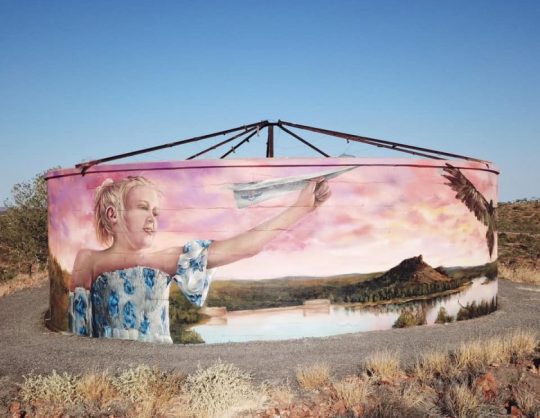
Drive North West Queensland. (n.d.) Water Tank Mural [Photograph]. Drive North West Queensland. https://drivenorthwestqld.com.au/things-to-do/water-tank-mural/

Massano, T. (2018). Highlighting An Iconic Dallas Landmark With Gobo Projections [Photograph]. Rosco Spectrum https://www.rosco.com/spectrum/index.php/tag/gobos-projected-onto-water-tanks/Dall

Russ. (2019). Silo Art Wagga to Weethalle [Photograph]. Marg and Russ. https://margruss.incoll.org/page/3/Russ
(March 22 2021)
0 notes
Text
Exploring projection and how it can be used in creative placemaking
Projecting images onto buildings, known as projection mapping, has become increasingly popular across music festivals, product launches, and as a form of public art (Creative Bloq Staff, 2020). Unlike a flat projection, projection mapping allows any surface to become a screen, with no distortion (Creative Bloq Staff, 2020).
One high scale example of projection mapping is Baird Manor, Utah, where an entire house was turned into a virtual haunted house for Halloween. During the 5 minute "movie", figures appear in windows, ghosts dance around the house, and the entire house bursts into virtual flames (Ockey, 2020).
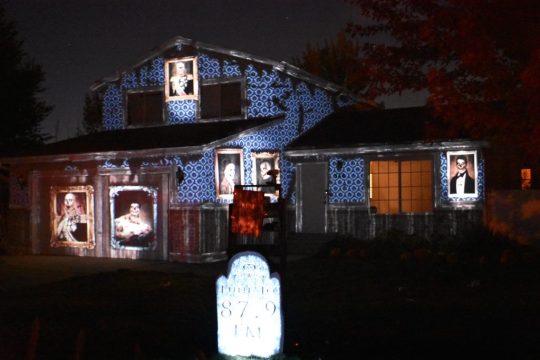
(Ockey, 2020)
Smaller scale projection mapping can be just as engaging as a large projection, if executed properly. Examples of smaller 2D projections can be found around Brisbane, such as in Wilston Village. Elysha Rei's Journey Ever Onward (2020) explores patterns based on symmetry and harmony found in nature and the local area's architecture (Brisbane City Council, 2021). As part of this series of work, three colourful artworks are projected along the footpath in Wilston Village, helping to enhance the nigh time experience of the village (Brisbane City Council, 2021).
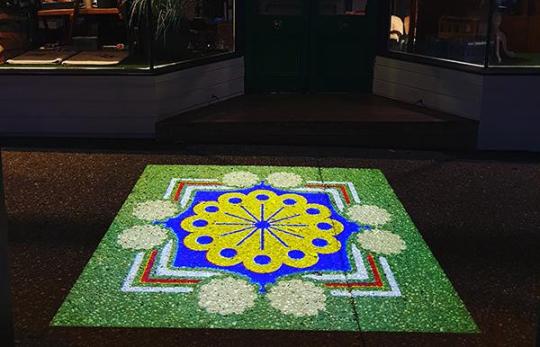
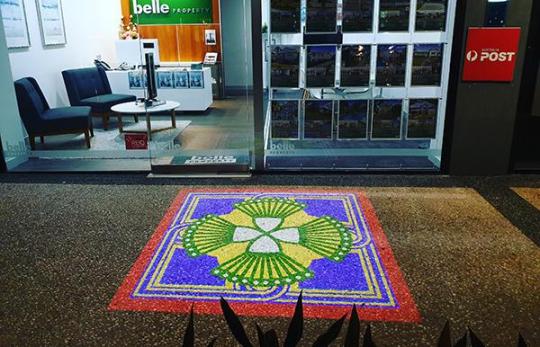
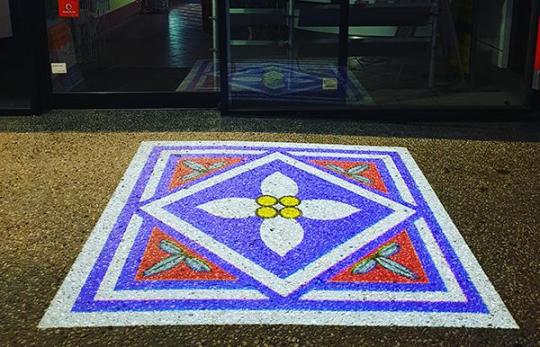
(Brisbane City Council, 2021)
Brisbane City Council. (2021). Public art and creative outcomes in Village Precinct Projects. Brisbane City Council. https://www.brisbane.qld.gov.au/planning-and-building/planning-guidelines-and-tools/village-precinct-projects/public-art-and-creative-outcomes#wilston
Creative Bloq Staff. (2020, October 26). 20 mesmerising projection mapping demos. Creative Bloq. https://www.creativebloq.com/video/projection-mapping-912849
Ockey, Natalie. (2020). Baird Manor Halloween Lights. Utah's Adventure Family. https://utahsadventurefamily.com/baird-manor-halloween-lights/
(March 21 2021)
0 notes
Text
Case Study: Urban Art Projects
Kraken, produced by Dutch artist Floretijn Hofman, and in collaboration with UAP, is a large playscape situated in Yantian, Shenzen, China. It draws inspiration from the site's location, formally occupied by a Soviet aircraft carrier that was used as a theme park.
The piece utilises several placemaking strategies, including drawing on the history of the site it sits on. In reference to the sea monster with a reputation for attacking ships, Kraken is able to draw on the history in a fun and creative way. Kraken is also interactive, serving as a children's playground as well as a piece of art.
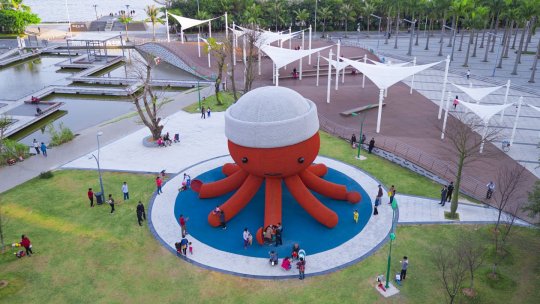
UAP. (n.d.) Kraken. UAP Company https://www.uapcompany.com/projects/kraken
(March 19 2021)
1 note
·
View note
Text
Sustainability
Sustainability is an important aspect of creative placemaking, not only in terms of environmental sustainability, but also in terms of social and economic sustainable. Environmental sustainability refers to the conservation of natural resources, economic sustainability refers to the cost of the project, and social sustainability, sometimes referred to as social equity, refers to the health of communities, empowering them to participate in the process (H2M Architects and Engineers, 2013).
Reusing and repurposing materials already on site is a great way to help make a project more environmentally sustainable. Materials at Northshore that can be repurposed include large amounts of old timber from the wharves, shipping containers, and old buoys. Some of these have already been used in places around Northshore, so including them would also help to ensure that the sites around Northshore have a similar theme.
Ensuring that the project has enduring significance is also important, and also helps ensure economic and social sustainability. To ensure any project at Northshore has enduring significance, it needs to remain relevant for many years after its first implementation, and be modifiable so that it can be expanded and built upon.
H2M Architects and Engineers. (2013, June 14). The Three E's of Sustainability. Blueprint https://h2mgroup.wordpress.com/2013/06/14/the-three-es-of-sustainability/
(March 19 2021)
0 notes
Text
Principles of Creative Placemaking
In the Tom Borrup reading, Creative Placemaking: Arts and Culture as a Partner in Community Revitalisation, 4 key principles for creative placemaking are cited. These are as follows:
It is grounded in the particulars of place
It employs authentic and ongoing community engagement
It embraces existing community development systems
It assumes the willingness and capacity of arts and cultural organisations to tale an outward orientation. In the process, artists at community-building tables can realise a new catalytic role on their community
These principles serve as a reminder that creative placemaking is an ongoing process, that aims at embracing and building on the already existing history of a place. In particular, they highlight the importance of community in the placemaking process.
The reading also discusses the idea that the process should build on the identity and history of a place, regardless of whether the history may be perceived as good or bad. This can be related back to Northshore, as while the indigenous history may not always be something we are proud of, it is still important to address.
Borrup, Tom; Rosewall, Ellen; Shane, Rachel. (2018) Arts and cultural management; critical and primary sources. Bloomsbury Academic
(March 19 2021)
0 notes
Text
Stakeholder Analysis
Target audiences for Northshore include new residents, current residents, destination visitors, tenants and occupiers (including Eat Street, Team Arrow and the men's shed located on site).
Stakeholders such as both new and current residents, as well as visitors can be engaged by creating more publicly accessible spaces around Northshore. According to the Marketing Appendix, these stakeholders are searching for unique experiences and connection to community. Projects that address both of these are ideal.
Tenants and occupiers require a project that wont compete with their already existing business, but will instead complement it, providing additional experiences for their customers and visitors to Northshore.
These stakeholders can be positioned on the following graph, to clearly illustrate their role in the creative placemaking project.
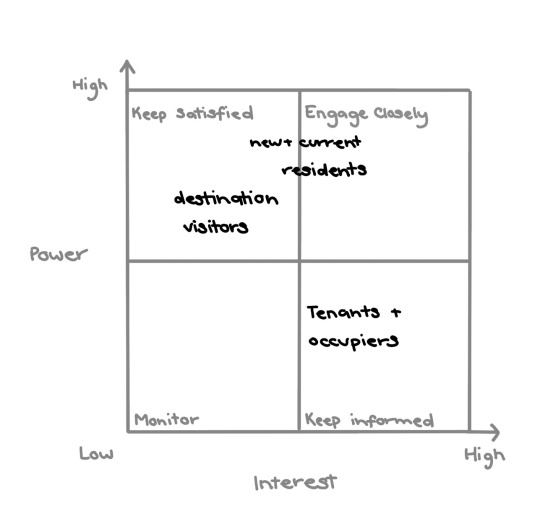
(March 19 2021)
0 notes
Text
Exploring Visitation and Diversity
What kinds of people visit Northshore? Why do they visit?
A number of people visit Northshore, mostly to access Eat Street. This includes families, younger couples without children, and teenagers. Other people also visit Northshore to access the Tennis Centre, when riding the ferry to the last stop, to visit the café, and occasionally to utilise the empty carparks during the day.
Who is Northshore's target audience?
According to the marketing appendix provided by EDQ, the target audiences for Northshore include:
B2C audiences:
New Residents
Current Residents and Workers
Destination Visitors
B2B audiences:
Tenants and occupants
Developers
How can we enhance the visitor and local community experience at Northshore?
We can enhance the experience at Northshore by providing more interactive elements, and creating spaces that are available 24/7. Creating interesting and inviting spaces, with lots of greenery and shade, will help entice visitors to stay longer. Other ways of potentially enhancing the experience may include the addition of digital innovations, such as QR codes around Northshore, and public art, to liven up the spaces outside of Eat Street.
(March 19 2021)
0 notes
Text
Case Study: Waterfront Toronto
Part of the waterfront revitalisation in Toronto, Canada, Underpass Park "transformed derelict and unused space beneath a series of overpasses into a unique community park" (WATERFRONTToronto, n.d.). The innovative use of public art, and the addition of a playground, skate park, and basketball half-courts helped to transform the space into a vibrant community asset (WATERFRONTToronto, n.d.).
This park utilised a number of placemaking strategies, including using art to draw people into and through the space. A strong emphasis on safety was also considered throughout the design process, and the park is lit with LED lighting, in-ground and in-wall lights, and diffuse spotlights (WATERFRONTToronto, n.d.). The emphasis on safety ensures that the community utilises the space at all times of day.

WATERFRONTToronto. (n.d.). Underpass Park. WATERFRONTTorontohttps://www.waterfrontoronto.ca/nbe/portal/waterfront/Home/waterfronthome/projects/underpass+park
(March 19 2021)
0 notes
Text


Initial Ideas
After visiting the site on the field trip, the old tank caught my eye. As a piece that already has history with the Northshore site, I thought it would be interesting to explore ways to add to this.
I had a number of initial ideas for my creative placemaking project, including:
Opening the tank up to allow visitors to walk inside, and displaying old images of the wharf inside - potentially interactive
Painting a mural on the outside of the tank, potentially done by an Indigenous local telling the story of the Northshore site
Projecting images and short videos onto the tank, depicting the history of Northshore
Using the ironbark from the wharves to create seating and garden beds around the tank, helping tie the tank to other locations around Northshore that also use the iron bark
While I quite like the idea of opening the tank up and allowing visitors inside, I believe that a large number of the $70,000 budget would have to go towards ensuring the tank is structurally safe, leaving not much left for the interactive element inside, so would not be feasible.
Projecting images on the outside would work well at night, but could be hard to see during the day. In contrast, a mural painted on the outside of the tank would be visible during the day but may be hard to see without adequate lighting during the night. Because of these two factors, I am going to explore how a combination of the two could be used to create a space that is translates easily between day and night.
(March 15 2021)
0 notes

